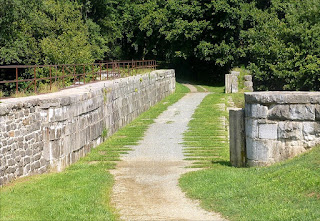The Chesapeake and Ohio Canal once connected the Georgetown section of Washington, DC with Cumberland, Maryland. It was intended to go all the way to Pittsburgh, where it would have ended at the Ohio River, but construction was discontinued after it reached Cumberland. Today, what remains of it, including its towpath, is a National Historical Park. During the 1990s, I explored all of it by bicycle, except for a small region that was closed off due to its own deterioration. Every once in a while, I go down to the canal and take a hike, or maybe just see a few sights. One place along the canal I recently visited is the Cushwa Basin in Williamsport, Maryland. Very close to the parking lot, which is just off US 11, is the Conococheague Aqueduct, named for the creek it spans. The aqueduct appears to have stopped some flotsam from reaching the nearby Potomac River.
A few hundred yards east of the aqueduct is an old railroad drawbridge. A system of cables and pulleys lifted the bridge straight up to allow canal boats to pass under it. Today, the bridge and its rail line are no longer in use. Boards nailed to the railroad ties allow pedestrians to walk across it. In this picture, the modern bridge behind the drawbridge is US 11.
I also took a swing by Cumberland, to see where the Chesapeake and Ohio towpath met the much more recently constructed Great Alleghany Passage, which will allow hikers and bikers to reach Pittsburgh, the original intended western terminus of the C&O. In front of the Western Maryland railroad station is a statue of a canal-boat-towing mule and his human handler.




No comments:
Post a Comment